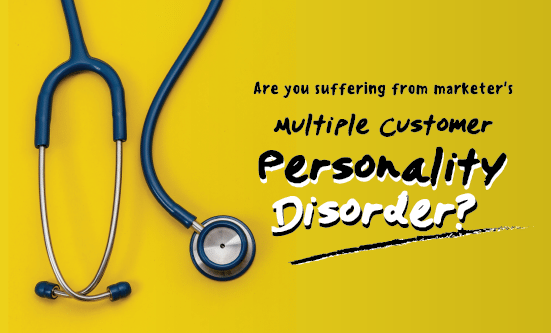Are you certain you know who your customer is? Perhaps you use one of the common industry synonyms such as consumer, member, client, visitor, or guest to refer to them? What about your partners and B2B revenue generating relationships? Are those customers too? The answer may not be obvious and those who fail to confront these important questions may be suffering from undiagnosed MCPD (Multiple Customer Personality Disorder), which when left untreated, can generate complications that work against your strategy and end goals.
Who is your customer?
At first blush, marketers tend to respond with the former group (“The end consumer! Of course!”) when asked to identify their customer. They may even cite examples of their robust customer-centric culture and strategy. The “other customers” only start to reveal themselves when you look closer at certain choices or compromises made everyday. If you work for an organization suffering from MCPD, some of these situations might sound familiar to you:
“I know end consumers are showing fatigue for this promotion, but our partner is really pushing us for higher conversions as part of our coalition program. I know most consumers won’t take up the offer, but we need to make the numbers we promised, even if it means alienating some of our base.”
“We have a clear mandate to better monetize visitors to our site. Total visits and engagement levels are down, but we should be able to make up the difference if we just add more space for banner ads.”
“Yes, I know our home page is really valuable. That’s exactly why we should make the most use of it for our supplier’s critical new product launch. They are counting on us to make huge noise about it and drive sales. Who cares if some of our customers wouldn’t be interested?”
Sound familiar? Once you start to consider your relationships with your partners, franchisees and suppliers, doing “what’s right for the customer” can be a balancing act of managing competing interests. On the one hand, the end consumer expects immediate and relevant content and offers, while your partnerships may demand overriding prioritization to deploy their most urgent bottom-line focused strategies and promotions.
What’s the prognosis? A cinema industry example
Isn’t inconveniencing some consumers a small price to pay when blasting promotions for critical new products and strategies works? The challenge is that this tactic only works for so long before the bombardment and alienation drives away the consumer; keep up the bad habit long enough, and your MCPD becomes chronic. While your new product launch may hit your target numbers today, you have also negatively contributed to customer engagement in your business. Worse, your MCPD has the potential to become pandemic and help define your industry as a whole.
Alienation and driving away customers sounds harsh; yet, this is what we are experiencing in the cinema business. The pattern of declining attendance and box office revenue is not a new story. Canada’s largest cinema, Cineplex Inc., experienced an attendance decline of 5.6% between 2016 and 2017¹, which is the new normal across the industry.
The prescription and the cure: personalize to fill every seat
While there are other contributing factors at play (such as the proliferation of home entertainment systems), there is hope for organizations with the courage to acknowledge and address their cases of MCPD head-on. This means making the “bums-in-seats” the priority for your marketing decisions which, sometimes is in opposition to prescriptive requests from your other customers (e.g. media buyers). After all, if the seats are empty, everyone loses.
With customers at the centre, filling seats means providing a service to visitors that is personalized on an individual basis. Yes, many people will be interested in and attend the next blockbuster, but increasing occupancy means reaching out individually to promote niche alternative programming options. If I’m really into Filipino language films, Opera or Ballet, I would find it helpful to have my interactions with the cinema tailored to reflect these preferences.
External industry threats such as NetFlix have proven the importance of personalized recommendations. Aside from the movie title recommendation, cinemas are well positioned to personalize even further when you consider the other dimensions that come with a brick-and-motor business: the cinema location, the showtime, traditional or premium video/sound, at-theater meal pairings, restaurant offers and games & entertainment.
This type of detailed personalization is complex, but problems like it are routinely solved today by leading organizations. Solving for these needs can often require tools that use narrow or specific artificial intelligence that I describe in “Marketing AI: Consciousness or Intelligence?“. Adopting these types of personalization capabilities is what makes the difference between a disengaged customer vs. one that looks forward to (and would miss) their regular interactions with your business.
¹ Cineplex Inc. Annual Report 2017
 By Joe Maraschiello, Business Development & Region Director at Digital Alchemy.
By Joe Maraschiello, Business Development & Region Director at Digital Alchemy.
[pardot-form id=”46577″ title=”Blog Sign up test1″]




